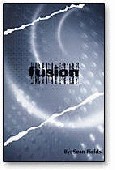Fusion
Fields, Sean
(Based on 1 review)

Reviews
(Top ▲)
If you're looking for a nice, visual torn and restored card, Fusion might be a good place to start.
Before I get into the content of my review, let me state for the record that I'm not familiar with Reparation, Reformation or any of the other recent "visual" T&R cards. When I performed this effect years ago, Paul Harris had the work on it and the emphasis wasn't on the "visual" restoration. So keep in mind that I'm looking at this with "virgin" eyes and will not be comparing/contrasting it with other products.
The technique is not extremely demanding in the technical area. I wouldn't call it easy, but if you can finger palm a quarter-card and have a bit of finesse, this should be within your grasp. Actually, finesse is what's really needed here. The performer's moves need to have some elegance to them to make this look right.
While it might have bumped up the price, this would have been much better as a multi-angle video shoot. There are plenty of pictures to accompany the text but some moves just aren't easy to describe with still shots (remember trying to learn card manip from the Ganson books?).
All of the moves seem to be fair and straightforward except for one. There's a point where the card is bent and then un-bent, supposedly just to crease it, but the "picture" from the audience's view changes when it should not have. I'm not sure if this is a big thing, but I felt it needed mentioning.
The routine has a nice ending taken from a David Williamson routine. I wonder if the author asked for permission to include this idea? At least he included a reference to David's book.
Overall, I think this is a fine visual restoration that is within the capabilities of most performers with a modicum of skill.
Before I get into the content of my review, let me state for the record that I'm not familiar with Reparation, Reformation or any of the other recent "visual" T&R cards. When I performed this effect years ago, Paul Harris had the work on it and the emphasis wasn't on the "visual" restoration. So keep in mind that I'm looking at this with "virgin" eyes and will not be comparing/contrasting it with other products.
The technique is not extremely demanding in the technical area. I wouldn't call it easy, but if you can finger palm a quarter-card and have a bit of finesse, this should be within your grasp. Actually, finesse is what's really needed here. The performer's moves need to have some elegance to them to make this look right.
While it might have bumped up the price, this would have been much better as a multi-angle video shoot. There are plenty of pictures to accompany the text but some moves just aren't easy to describe with still shots (remember trying to learn card manip from the Ganson books?).
All of the moves seem to be fair and straightforward except for one. There's a point where the card is bent and then un-bent, supposedly just to crease it, but the "picture" from the audience's view changes when it should not have. I'm not sure if this is a big thing, but I felt it needed mentioning.
The routine has a nice ending taken from a David Williamson routine. I wonder if the author asked for permission to include this idea? At least he included a reference to David's book.
Overall, I think this is a fine visual restoration that is within the capabilities of most performers with a modicum of skill.








